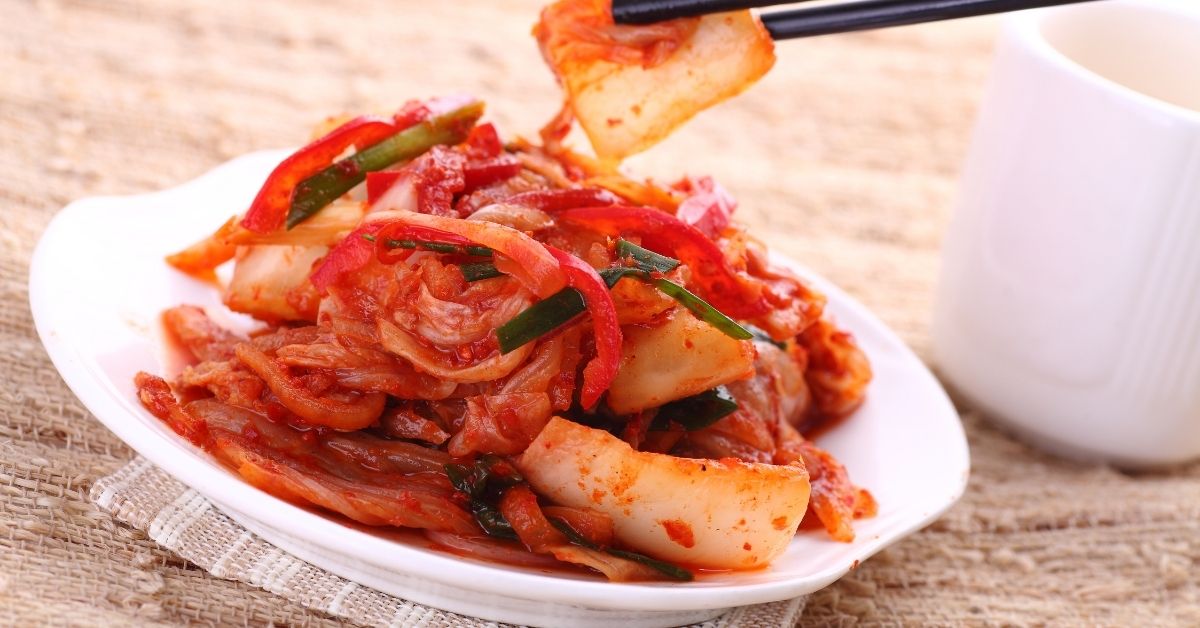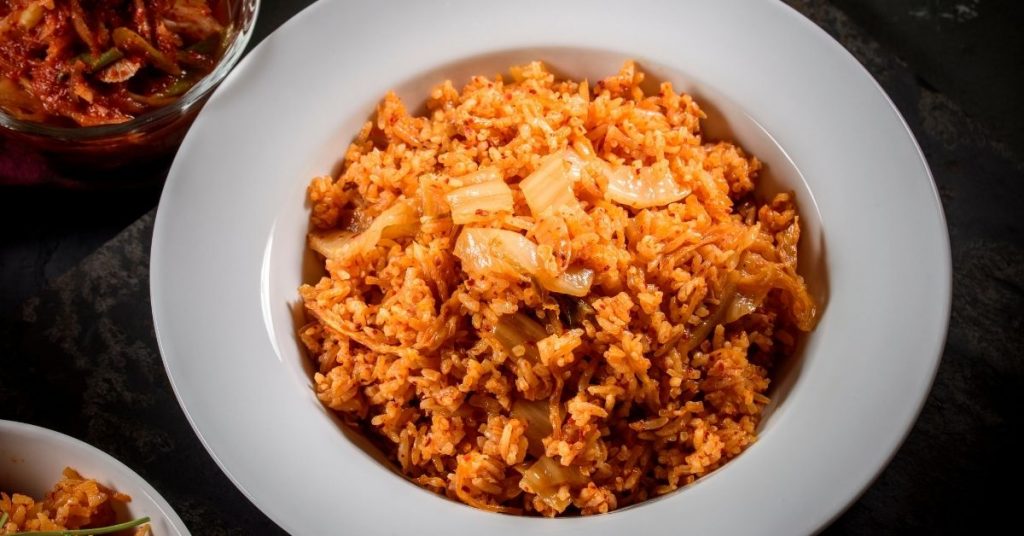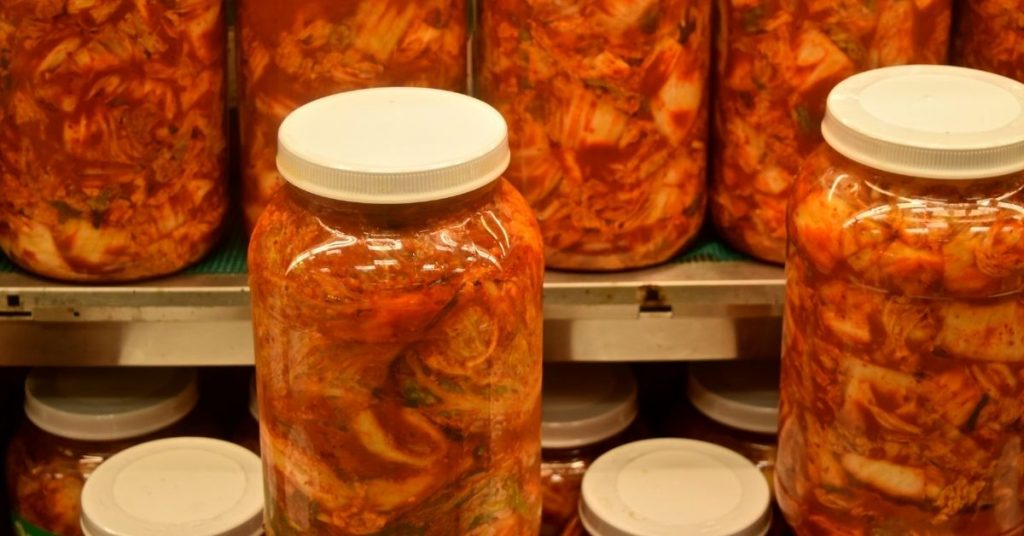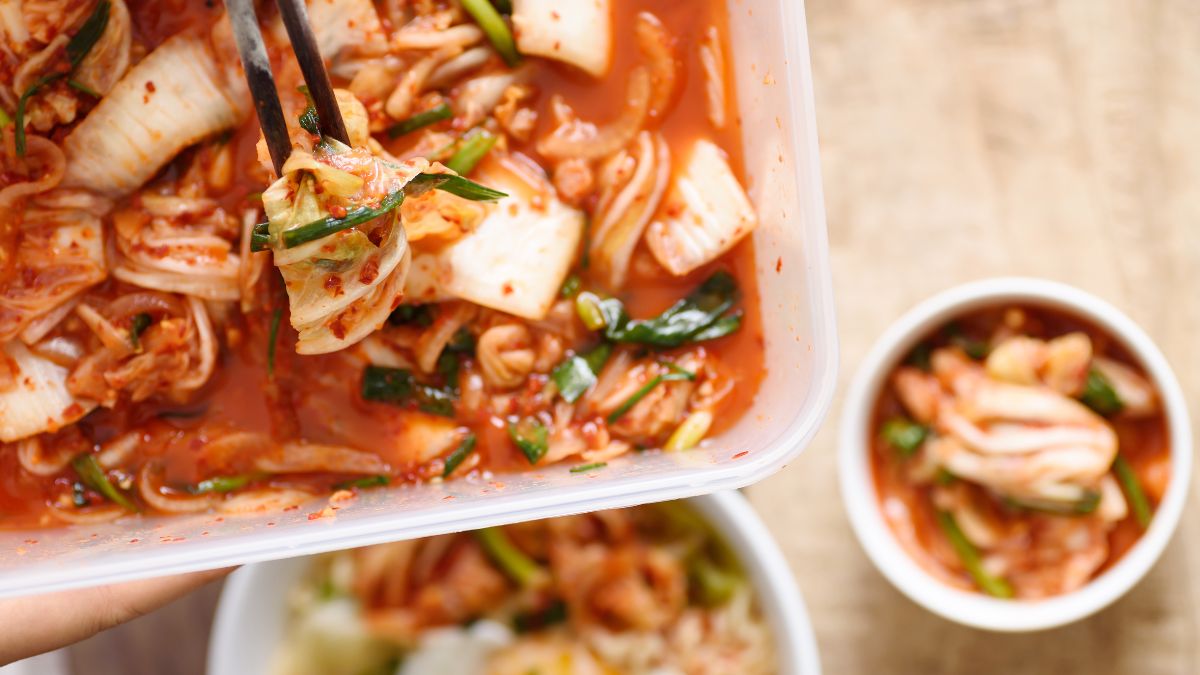How to Make Kimchi Taste Better? 21 Tips to Try

Kimchi is a traditional Korean side dish made of salted and fermented vegetables. When done right, it’s an extraordinary culinary experience. And making it is my favorite — it’s so easy to get caught up in the process that you end up not thinking about anything else. It’s like a vacation for the mind. Still, if you end up buying it from the store, it will not taste the same — you may even have to adjust it to your liking. So, how to make kimchi taste better?
To make kimchi taste better, mix it with rice or noodles. If it’s too strong, rinse it and serve. To improve kimchi’s taste, you can also sauce it up with BBQ, curry, or ketchup sauce. To bring the most out of kimchi, serve it with roasted meat, chicken in panko breadcrumbs, or bao buns.
In my pursuit of the best possible kimchi, I have experimented with many types of vegetables and various types of brining methods. Since kimchi is more of a technique than a recipe, it offers a wide variety of tastes. In the following paragraphs, I will share my knowledge on improving your kimchi’s flavor, fixing bad kimchi, combining kimchi, and storing it.
How to Improve Kimchi’s Taste?
If you already bought or made kimchi, the taste of which doesn’t seem just right for you, there are things you can do to improve it. A pinch of salt or a nice rinse can go a long way, but there are more tricks to make it perfect for you.
Serve Your Kimchi Properly
Kimchi goes excellent with rice, noodles, chicken in panko breadcrumbs, bao buns, and roasted meat. As a side dish, you can, of course, combine it with whatever food you like. However, be very careful when you use it as an ingredient. Nothing can ruin your kimchi like combining it with the wrong dishes.
The worst combination I have ever had is the one with cabbage rolls — so definitely stay away from this one. I also don’t like kimchi and tuna combinations. Still, the best thing is to try it out for yourself.
Mix Kimchi and Roasted Meat
Kimchi goes great with roasted meat or other dishes containing it. The fresh and crunchy side of the kimchi combines perfectly with the salty and soft side of the meat. Delicious!
Mix Kimchi and Rice
Kimchi is a great addition to rice. Whether you have it as a side dish or as an ingredient to the rice, it will do a great job. You can sizzle it for a minute in a pan, put some sauce on it, and pour it over a bowl of cooked rice.
Another way to combine kimchi and rice is to cook it together with the rice. Sizzle it on a pan and add the rice. Pour some kimchi juice and let it cook. Serve it with some green onion and sesame seeds, and you will have delicious kimchi fried rice in a matter of minutes!

Mix Kimchi and Noodles
You can turn kimchi into noodle sauce, or you can simply top your noodles with it. Fry the kimchi for a minute and add some soy sauce. Stir and put the cooked noodles in the pan. Add water or kimchi juice if you need to, and enjoy the delicious and effortless meal.
Rinse Rinse Rinse
A common problem with storebought kimchi is that you don’t know how long it has been fermenting. The longer it ferments, the sourer the taste. So, if your kimchi is more bubbly than you would like, you can rinse it off.
Another useful tip is to let it sit in a bowl of cold water for 20 minutes to let out the extra sourness. Never use warm or hot water, though, as it will ruin its structure. Kimchi is supposed to be crunchy, and the warm or hot water will make it soft and bland.
Sauce It Up
The great thing about kimchi is that it’s very prone to absorbing different flavors. It can be sour, bitter, or salty, and you can still tailor it to your taste with just a few drops of sauce.
Soy sauce is the most commonly used one, but there are also others you can add to your kimchi. Honey dip is excellent for kimchi. The zestiness of the kimchi will mash up nicely with the sweetness of the honey.
Another great solution is kimchi marinara sauce. Since tomatoes are the main ingredient of the marinara sauce, they will add freshness and mild sweetness to your kimchi.
If you plan to have kimchi with roasted meat, barbeque sauce is the perfect solution. Kimchi mixed with barbeque sauce results in a perfect combination of sourness, tanginess, and a distinct smoky flavor.
Brine sauce is another solution and a way to use up the leftover brine. Just add mayo and sour cream to the brine, and you have a creamy, smooth, and soft sauce to mix your kimchi with.
We can’t talk about kimchi sauces without mentioning Korean fish sauce. Since fish goes excellent with and is sometimes an ingredient to kimchi, this fish sauce will fit perfectly into the story.
How Do You Fix Tasteless Kimchi?
Even though you’ve done everything correctly, sometimes the fermentation process can go wrong, and your kimchi will be bland or tasteless. Don’t be disappointed, as this is fixable.
Add Salt
The simplest way to bring the flavors back to your kimchi is to add salt. The salt will not only make it taste saltier but will also amplify the other flavors.
Add Paste
Another way to make your kimchi flavorful again is to add more kimchi paste. Be careful with this because adding too much would render it inedible.
Add Soy Sauce
Soy sauce is a very safe solution for bland kimchi. Soy sauce isn’t too strong to overwhelm the flavor and take over, but it isn’t that mild, either.
If your kimchi is tasteless, slowly add soy sauce until you get the taste you want. Also, you can add miso paste or fish sauce.
Remember, your kimchi isn’t tasteless because it lacks taste, but because the chemical reaction has passivized the flavor. You only need to wake up the flavors that are already there. Therefore, whatever you add, add it slowly, mix, and wait for a minute before trying and adding more.
Also, not all kimchi is made the same — there are many different types and brands. I think the ones in this video are a great starting point if you want to set off onto a kimchi testing journey.
How Do You Fix Bitter Kimchi?
To some extent, kimchi has a natural bitterness, but bitter isn’t how it is supposed to taste. Again even though you did everything right, sometimes the chemical reactions have a mind of their own. Bitterness is easily fixable, so don’t despair.
Soak It in Cold Water
If your kimchi is expressly bitter, soak it in cold water overnight to wash off the excess lactic acid that triggers this taste.
Add Sugar
I like to add one teaspoon of sugar to a cup of bitter kimchi. This dissolves the bitterness and brings back the natural flavors with a touch of sweetness.
Layer Your Kimchi Over Fresh Veggies
Choose vegetables that don’t contain sugar and layer your kimchi over them. Add soy sauce, fresh garlic, and vinegar. Your kimchi should be good after two to three hours.
How to Make Sure That Homemade Kimchi Tastes Good?
Considering that kimchi offers countless possibilities in terms of ingredients and seasoning, there is more than one way to influence its taste.
It is essential to know that there isn’t just one recipe for kimchi, and you don’t necessarily need to follow your recipe to the letter. Kimchi is more of a technique than a recipe, and as such, it requires some, at least, basic knowledge of food preservation and brining.
Choose Seasonal Vegetables
Although the best-known ingredients are napa cabbage and Korean radish, you can make kimchi with whichever vegetables you like. Choosing seasonal vegetables is a great way to go because your kimchi will taste heavenly and fresh.
In addition to the traditionally used vegetables, you can make kimchi with carrots, scallions, or cucumbers.
Choose the Right Kimchi Season
The best time to make kimchi would be from autumn until early spring. This way, you will allow your kimchi to ferment properly and at its own pace.
Summer and late spring aren’t the best time to make kimchi. Because kimchi needs to ferment, the warm weather and high temperatures won’t be favorable for the fermentation process. The warmth will cause the kimchi to rot, so instead of being crunchy, zesty, and tangy, it will be soft, slimy, and you better not taste it like this.
Salt Carefully
Too much salt will ruin your kimchi, as it will penetrate too deep into the vegetables and cause them to rot. Salt is essential to bringing, and you should be very careful how much you salt, as it will affect not only the taste but also the structure.
On the other hand, too little salt will make it taste bland. The recommended ratio of salt and water is 1 11/4 teaspoon of salt for one cup of water. So essentially, the amount of salt you add will depend on the amount of water, and the amount of water will depend on the amount of vegetables.
The recommended amount of water is the amount that is just enough to submerge the vegetables in.
Pack Tightly

Air is the kimchi fermentation process’s worst enemy. When you pack your kimchi for fermentation, you need to pay at most attention to packing it tightly and preventing air from going inside.
This is why I like to pack my kimchi into a Mason jar or another type of airtight container. You also need to use something to press it down so that the vegetables are tightly compressed.
Adjust Your Kimchi to Your Own Taste
When it comes to kimchi taste, everything you decide goes. Kimchi’s recognizable taste is sour, with a hint of bitterness, but you can add more flavors to it if you like.
Feel free to add whatever spices you like to the kimchi paste. From black pepper to paprika to garlic and onions. The symphony of flavors is yours to create.
You can combine salt, black pepper, paprika, ginger, dried or fresh onions/garlic. You can mix things up by adding Korean fish sauce, miso sauce, fermented squid, anchovies, or prawns. If you want your kimchi more on the hot side, feel free to add some chili powder or chili sauce to the kimchi seasoning.
Give It Time
You shouldn’t rush the fermentation process. Your kimchi can ferment from one week to one month, depending on what vegetables you use. During this time, you should leave it alone and let it ferment at its own pace.
The frequent opening and inspections will cause your kimchi to rot, as you will be letting air inside the container. In addition, taking out a piece of vegetable each time you open it, you will let air between the pieces, which will decompress them.
Sometimes it is hard to just let it ferment and forget about it, but you have to if you want the best possible taste. If you can’t help yourself from glimpsing, it’s best to put it in transparent containers and observe without opening them.
Give It Space
Make sure you let your kimchi ferment in a dark room. Sunlight isn’t what you want for the fermentation process. Remember, you are fermenting vegetables that have sunlight receptors. Leaving the kimchi exposed to the sun will rot it or ruin the taste at best.
If, however, you don’t have a dark enough area, you can improvise and cover the containers with a towel to keep the sunlight from penetrating the containers. Another good solution would be to leave the containers in the fridge.
The Magic Is in the Paste
The kimchi paste is just as important as the rest of the procedures involved in the kimchi-making process. The paste is the flavorful part of the kimchi that you must carefully select and incorporate.
The kimchi paste is essentially the selection of spices you will use for your seasoning. In addition to your kimchi being sour and tangy, it can also be spicy, mildly hot, or even discretely sweet as a result of the fermentation process. It all depends on the paste you use.
You can either buy or make your own paste. However, you must know precisely what you want your kimchi to taste because once you add the paste, it will taste just like that.
In addition to the spices, you can also use fish sauce or fermented shrimp in your paste. The fermented fishy aroma is quite complementary to the fermented kimchi flavor.
In my experience, kimchi goes great seasoned with paprika and just a few grains of sugar, mixed with powdered garlic and black pepper. But that’s just my preference. You should feel free to create your own magic.
Keep It Clean
Keeping everything clean is imperative in food preparation, but it is beyond essential when it comes to kimchi. Wash your vegetables, knives, and jars as thoroughly as possible. The microscopic bacteria that you might leave can and will rot your kimchi.
While these microscopic rascals will disintegrate in thermally processed dishes, such as fried, boiled, or baked, they will multiply and rot the entire thing in the fermented ones. Therefore, it is crucial to keep everything spotless and sanitary.
Combine Brining Methods
To make the most of your kimchi, consider combining two brining methods — dry and wet.
Both are very simple, and they work best when combined. First comes the dry brining. Here, you should cover the vegetables in salt and let them sit for a couple of hours.
The salt will soften the vegetables, absorb their moisture, and make them more receptive to the flavors you will add later. This means that your kimchi will have a more pungent taste in the end.
After the dry brining, continue with the wet brining method. The wet brining method combines salt and water. Submerge your vegetables in the salt and water mixture, whereby the water amount should be just enough to cover them.
Cut Vertically
Another vital factor, taste-wise, is how you cut the vegetables. All vegetables you use should be cut by length, so vertically, not horizontally.
If the vegetable has a core or another hard part, you should remove it. The smaller the vegetable pieces are, the shorter the fermentation process will be.
Choose the Right Containers

I already mentioned that kimchi needs to ferment in airtight containers. However, another thing to keep in mind is their size.
The container should fit the quantity of the vegetables fermenting inside. So, don’t use containers that are too big. If your container fits three pounds of content and has only ½ pound of vegetables, you should use a smaller container.
The emptier the container is, the more air bubbles will form between the layers of your vegetables. The empty space in the jar should be minimal, if any.
What Does Kimchi Actually Taste Like?
No matter what you put in the kimchi paste, its primary and most recognizable flavor will be sour, zesty, and tangy. Depending on the ingredients in the paste, it can also be mildly bitter, discretely sweet, or maybe a bit hot.
The primary source of the flavor is, by far, the fermentation process. If it weren’t for the fermentation process, kimchi would have tasted very different. The other flavor sources are, naturally, the vegetables and, of course, the ingredients you add to your paste.
What Tastes Good With Kimchi?
Kimchi tastes great on its own, so you don’t have to mix it with anything. However, it has the power to transform a mild and bland dish into a really flavorful experience. Therefore, it is a shame not to use it.
Kimchi goes perfectly with rice and noodles. It will enrich and spice them up very nicely. Just mix your rice or noodles with the kimchi, let them simmer for a minute, and you’ll have a great meal in your hands.
Mix it into fritters or meat patties. Just add your kimchi to the standard recipe, and fry. Another excellent use for your kimchi is to add it to a tofu stew. It will spice it up and give it a pleasant herbal aroma.
Add it to your scrambled eggs. You will be amazed at how good kimchi goes with fried eggs. You might also like to try it as a dumpling filling.
You can also turn it into a pasta sauce or even a pizza topping.
How to Eat Kimchi, Hot or Cold?
Depending on our preference, both hot and cold can do a great job. If you have it as is, alone, without any additions, I’d recommend having it cold. If you decide to mix it, or use it as part of another dish, follow the particular recipe or listen to your instincts.
How Long Does Kimchi Last?
At room temperature, kimchi can last one week after opening. The refrigerator keeps it fresh for much longer, three to six weeks. However, it continues to ferment, so it may taste sourer each time. Keep at a temperature below 39 °F, i.e., 4 °C, to keep it from going bad.
What are your favorite kimchi dishes? Excited to hear from you in the comments below!

Kimchi Fried Rice
Ingredients
- 1 tbsp vegetable oil
- 2 eggs
- 1 onion small one
- 1 clove garlic
- 1 cup kimchi chopped
- 2 cups rice cooked
- 1 tsp salt
- 1 tsp pepper
- ¼ cup soy sauce
Instructions
- In a large skillet over medium-high heat, add 1/2 tablespoon vegetable oil.
- Once the oil is hot, add the eggs to skillet and scramble them. Remove the scrambled eggs from the skillet and set aside in a bowl.
- Add the remaining 1/2 tablespoon vegetable oil, onion, garlic, soy sauce, and kimchi. Sauté until onion is translucent and cooked through, for about 3 minutes.
- Add the rice to the skillet and carefully break it up with your spatula or wooden spoon.
- Turn the heat down to medium-low, and continue to stir the rice into the mixture until all is incorporated. Finally, add the scrambled eggs and season with salt and pepper.
- Serve and enjoy!
